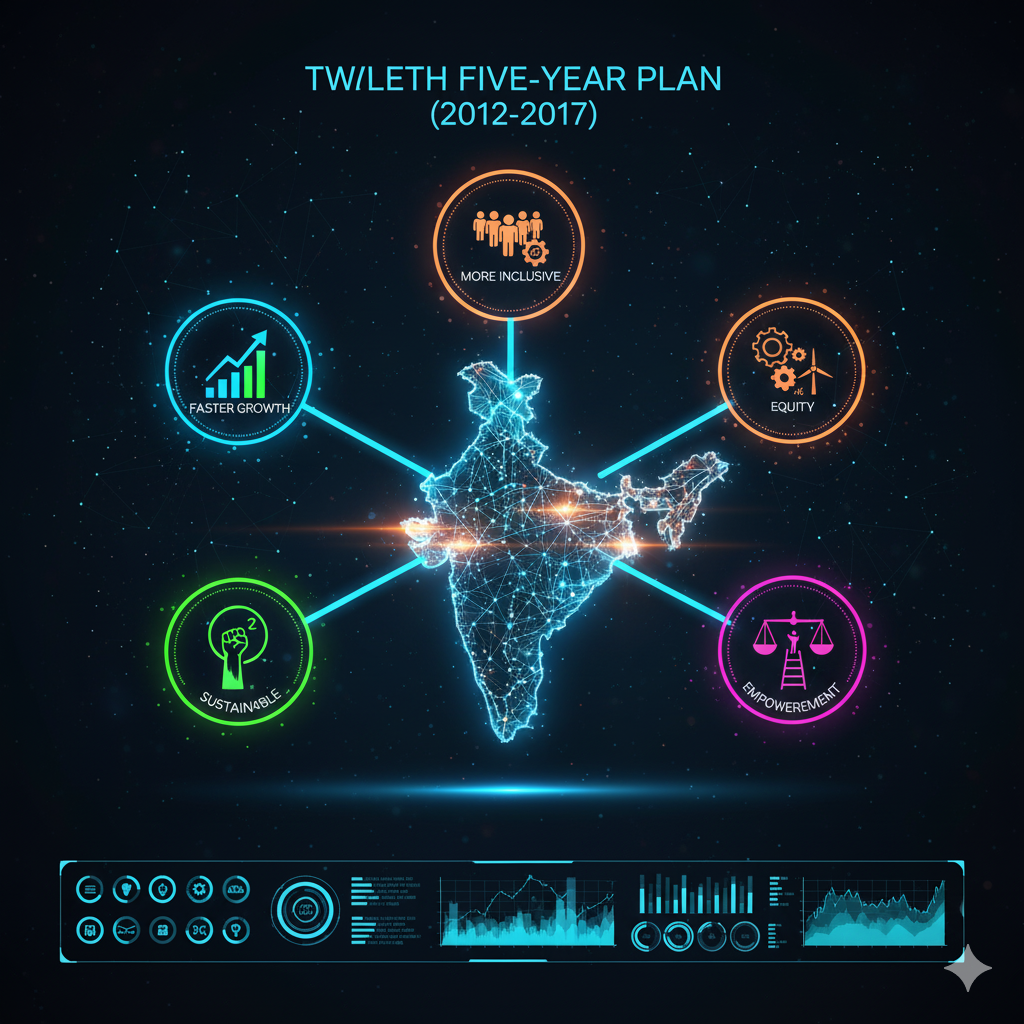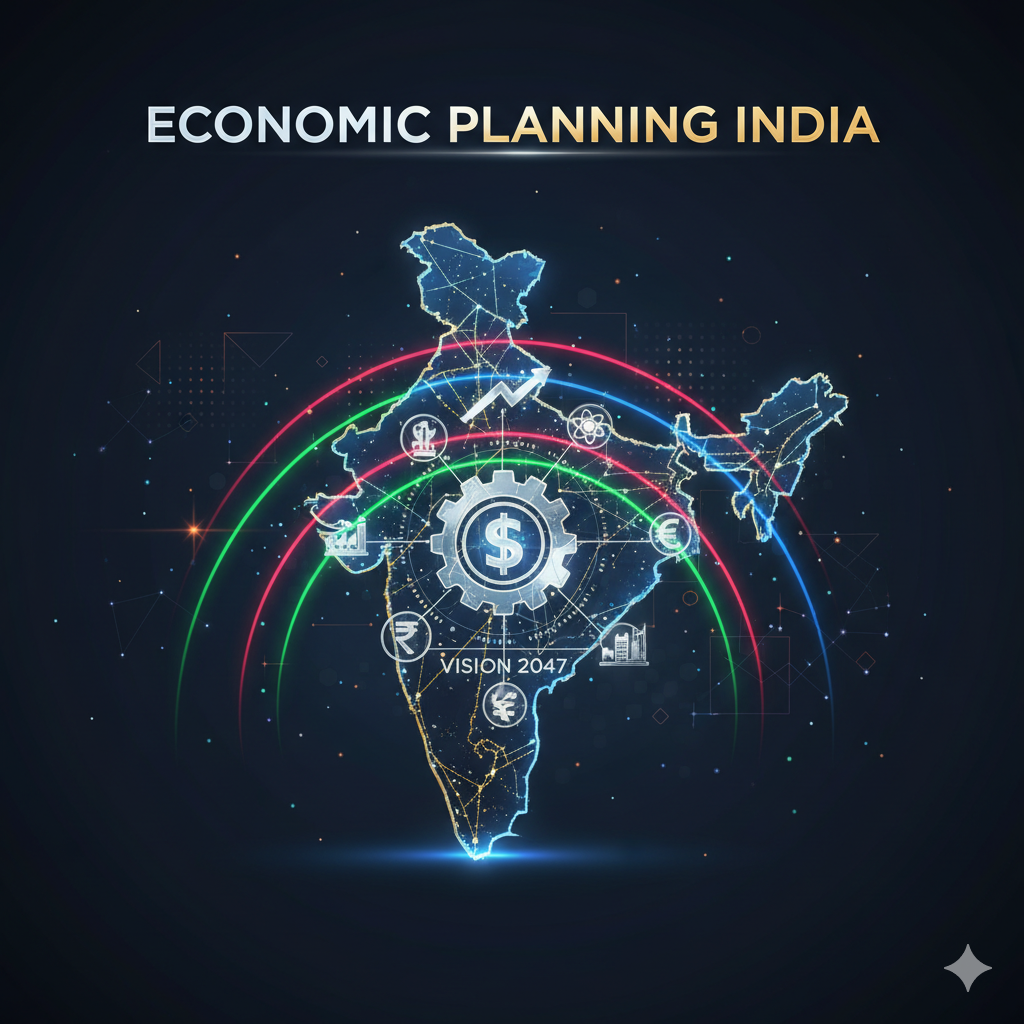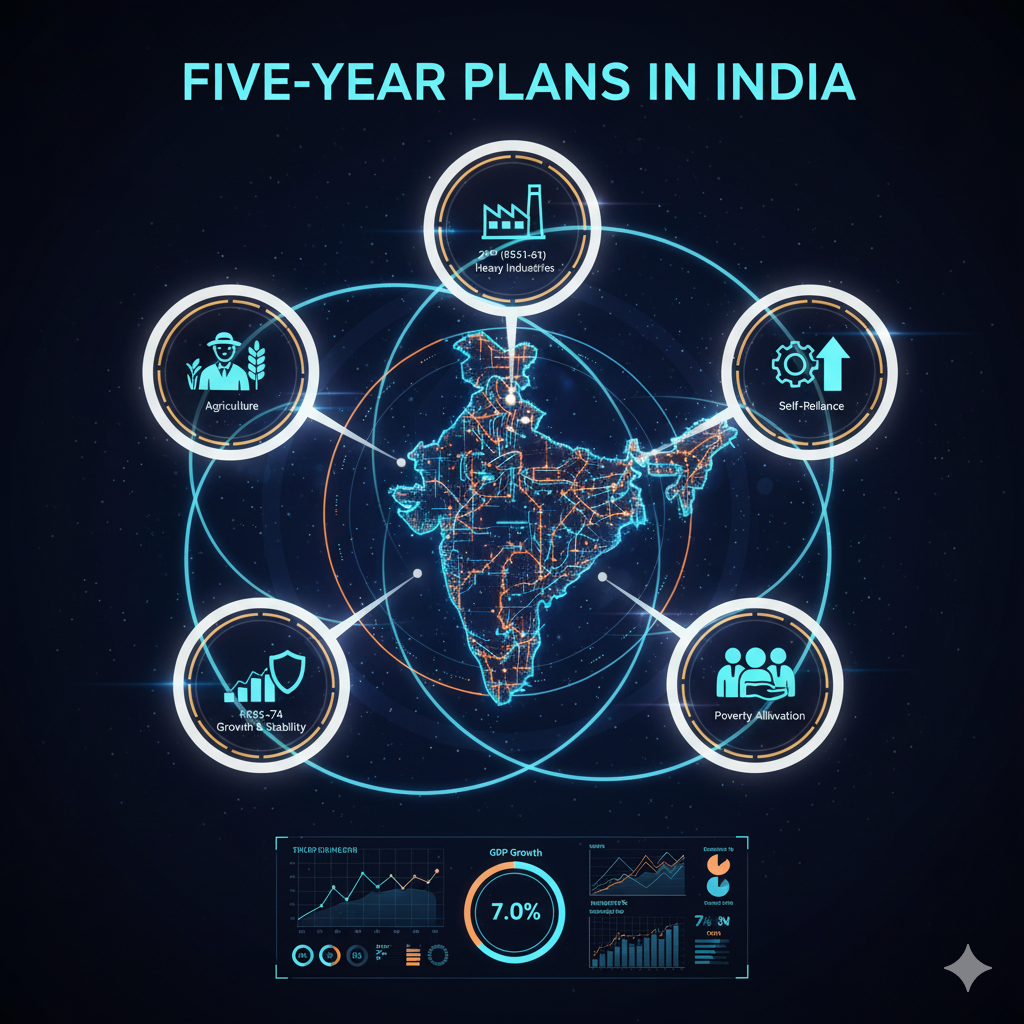Introduction
The Twelfth Five-Year Plan (2012–17) marked the last in the series of Five-Year Plans implemented by the Planning Commission of India before its dissolution in 2014. The Plan was a continuation of the country’s strategy for inclusive, sustainable, and rapid economic growth, building upon the achievements of previous plans.
Formulated in the backdrop of global economic uncertainties, the Plan emphasized a balanced approach between growth, social justice, environmental sustainability, and employment generation. Its central theme was “Faster, More Inclusive, and Sustainable Growth”.
The Twelfth Plan aimed to accelerate progress in human development indicators, reduce regional disparities, and address emerging challenges in agriculture, industry, infrastructure, and social sectors.
Historical Context of the Twelfth Five-Year Plan
India had experienced robust growth in the previous decades, with the Eleventh Five-Year Plan (2007–2012) achieving an average GDP growth rate of 8%. However, the global financial crisis of 2008–09 and subsequent slowdown highlighted vulnerabilities in the Indian economy, including:
- Declining industrial growth.
- Rising inflationary pressures.
- Persistent unemployment and underemployment.
- Environmental degradation.
- Regional imbalances and social inequalities.
In this context, the Twelfth Plan was formulated to bridge the gap between growth and inclusiveness, ensuring that economic development reached all sections of society while preserving ecological balance.
Objectives of the Twelfth Five-Year Plan
The Twelfth Plan identified several key objectives:
- Sustainable Growth: Achieve an average annual GDP growth rate of 8%, ensuring long-term economic stability.
- Inclusive Development: Reduce income inequalities, expand social services, and empower marginalized communities.
- Employment Generation: Create sufficient job opportunities, particularly for youth and women.
- Human Development: Improve education, healthcare, and skill development.
- Agricultural and Rural Development: Enhance agricultural productivity and rural infrastructure.
- Industrial Growth and Manufacturing: Strengthen the manufacturing sector to increase competitiveness.
- Infrastructure Development: Expand energy, transport, water, and urban infrastructure.
- Environmental Sustainability: Promote renewable energy, reduce carbon footprint, and protect natural resources.
- Governance and Institutional Reform: Strengthen institutions, improve service delivery, and enhance transparency.
Focus Areas of the Twelfth Plan
The Twelfth Plan prioritized key sectors and areas to achieve balanced development:
1. Economic Growth and Stability
- Targeted an average GDP growth rate of 8% over the Plan period.
- Focused on stabilizing inflation and enhancing fiscal discipline.
- Encouraged investment through public-private partnerships and foreign direct investment.
2. Agriculture and Rural Development
- Strengthened agriculture infrastructure, including irrigation, storage, and marketing facilities.
- Promoted sustainable farming practices and increased crop productivity.
- Aimed at doubling farmer incomes through technology adoption and credit support.
- Expanded employment opportunities through rural development programs like MGNREGA.
3. Industrial and Manufacturing Sector
- Boosted manufacturing sector growth to 12–14% per year.
- Focused on Make in India initiatives and domestic value addition.
- Encouraged modernization, skill development, and research & innovation.
- Promoted micro, small, and medium enterprises (MSMEs) as engines of employment.
4. Services Sector
- Encouraged growth in IT, finance, health, education, and tourism sectors.
- Emphasis on service exports to improve foreign exchange earnings.
5. Infrastructure Development
- Significant investment in power generation, transmission, and renewable energy.
- Expansion of roads, railways, ports, and urban transport systems.
- Development of smart cities and urban amenities to accommodate growing urban population.
- Improvement of water supply, sanitation, and housing facilities.
6. Education and Skill Development
- Universalization of secondary and higher education.
- Expansion of vocational training and skill development programs.
- Emphasis on quality education, teacher training, and curriculum modernization.
7. Health and Nutrition
- Reduction of maternal and infant mortality rates.
- Strengthening primary healthcare infrastructure.
- Promotion of immunization, nutrition programs, and public health awareness.
8. Social Justice and Poverty Alleviation
- Targeted inclusive growth for marginalized communities, including SC/ST and minorities.
- Expansion of social protection schemes like public distribution system (PDS), rural employment guarantee, and social insurance.
9. Environment and Sustainable Development
- Integration of environmental considerations into development plans.
- Promotion of renewable energy sources (solar, wind, biomass).
- Conservation of forests, water resources, and biodiversity.
- Reduction of greenhouse gas emissions and climate change mitigation measures.
10. Governance and Institutional Reforms
- Strengthening state capacity, transparency, and accountability.
- Expansion of e-governance initiatives to improve service delivery.
- Promotion of decentralized planning and participatory governance.
Targets under the Twelfth Five-Year Plan
The Twelfth Plan set quantitative and qualitative targets across various sectors:
1. Economic Growth
- Achieve an average annual GDP growth of 8%.
- Maintain inflation below 5–6% to protect purchasing power.
- Increase investment rate to around 36–38% of GDP.
2. Agriculture
- Increase agricultural growth to 4% per year.
- Raise food grain production to 300 million tonnes by 2017.
- Expand irrigation coverage from 55% to 60% of net sown area.
- Enhance farmer incomes and reduce rural poverty by 10–15%.
3. Industry
- Achieve 12–14% annual growth in manufacturing.
- Improve industrial competitiveness through technology, R&D, and infrastructure.
- Create approximately 10–12 million new jobs in the industrial sector.
4. Infrastructure
- Add 78,000 MW of power generation capacity by 2017.
- Build 50,000 km of national highways and expressways.
- Develop urban infrastructure to meet the needs of 600 million urban residents by 2030 (long-term vision).
5. Education
- Increase gross enrollment ratio (GER) in secondary education to 75%.
- Universalize access to higher secondary and higher education.
- Train 1 crore skilled youth through vocational programs.
6. Health
- Reduce infant mortality rate to 28 per 1,000 live births.
- Reduce maternal mortality ratio to 1 per 1,000 live births.
- Achieve 90% full immunization coverage.
7. Social Inclusion
- Ensure 90% of eligible households receive benefits under PDS.
- Reduce urban and rural poverty by 10–15%.
- Increase employment for women and marginalized communities by at least 15%.
8. Environment
- Increase renewable energy capacity to 50,000 MW.
- Afforest 5 million hectares of degraded land.
- Reduce energy intensity of GDP by 20%.
Implementation Mechanisms
The Twelfth Plan relied on integrated planning, monitoring, and evaluation mechanisms to achieve its targets:
- Planning Commission Oversight: Coordinated with ministries and states to ensure plan objectives were met.
- State Participation: States prepared state-level plans aligned with national priorities.
- Sectoral Ministries: Monitored and implemented sector-specific programs.
- Public-Private Partnership (PPP): Encouraged private sector investment in infrastructure and social services.
- Monitoring and Evaluation: Mid-term appraisals and annual reports tracked progress.
- Decentralization: Panchayati Raj institutions and urban local bodies were given responsibilities for implementation at the grassroots level.
Achievements and Challenges
Achievements
- Strengthened social sectors (education, health, rural employment).
- Increased infrastructure investment in roads, power, and urban development.
- Expansion of renewable energy projects and environmental initiatives.
- Growth in manufacturing and services sector contributed to employment creation.
Challenges
- Global economic slowdown affected growth momentum.
- Inflation and food price volatility impacted the poor.
- Employment generation lagged behind demographic requirements.
- Regional disparities in development persisted.
- Environmental sustainability goals required more effective enforcement.
Significance of the Twelfth Five-Year Plan
- Final Plan of the Planning Commission: Served as the culmination of India’s decades-long centralized planning experience.
- Inclusive Growth Agenda: Emphasized social justice and equitable development.
- Sustainability Focus: Integrated environment-friendly policies into economic planning.
- Transition to NITI Aayog: Provided a foundation for the shift from Five-Year Plans to the 15-Year Vision Document and 3-Year Action Agenda.
- Comprehensive Framework: Balanced economic, social, and environmental objectives in a single planning document.
Transition from Five-Year Plans to NITI Aayog Framework
Post-2014, the Planning Commission was replaced by NITI Aayog, introducing a new planning structure:
- 15-Year Vision Document: Long-term goals (up to 2030).
- 7-Year Strategy: Medium-term actionable strategies.
- 3-Year Action Agenda: Immediate policy priorities.
The Twelfth Plan served as a bridge between centralized planning and the new outcome-focused, cooperative federalism model, ensuring continuity in India’s development trajectory.
Conclusion
The Twelfth Five-Year Plan (2012–17) marked the end of an era in India’s economic planning history. With the theme “Faster, More Inclusive, and Sustainable Growth”, it attempted to address both growth and equity challenges simultaneously.
While the Plan achieved significant progress in social sectors, infrastructure, and renewable energy, challenges like employment generation, inflation, and regional disparities persisted. Its emphasis on sustainability, human development, and social inclusion laid the groundwork for India’s new planning framework under NITI Aayog, representing a shift from rigid, centralized plans to flexible, outcome-based, and participatory planning.
The lessons from the Twelfth Plan continue to inform India’s development strategies and long-term vision for 2047, as the nation seeks to become a prosperous, inclusive, and sustainable economy.




